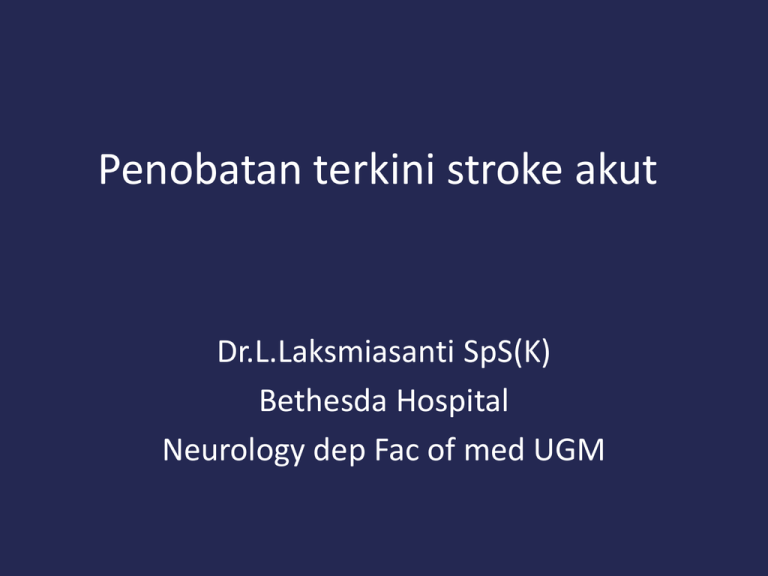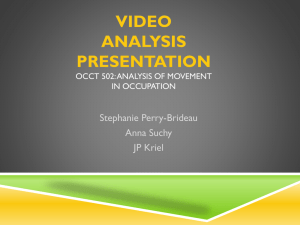
Penobatan terkini stroke akut
Dr.L.Laksmiasanti SpS(K)
Bethesda Hospital
Neurology dep Fac of med UGM
stroke 2013:44:870-947
Tujuh tindakan berantai untuk survival
dan penyembuhan stroke
Pre-arrival:
1. Detection
2. Dispatch
3. Delivery
Post-arrival:
4. Door
5. Data
6. Decision
7. Drug
4
1. Detection: Early Recognition
• Pengobatan dini stroke tgt pada penderita,
keluarga atau siapa saja yang mendapatkan
dan mengetahui ada kejadian stroke.
• Gejala sstroke yg ringan sering diabaikan baik
si pasien maupun keluarga.
5
2. Dispatch: Early EMS Activation and Dispatch
Instructions
• Pasien Stroke dan klg harus segera
memikirkan dan memanfaatkan segera EMS
segera setelah menemukan tanda2 seseorang
terkena stroke.
• EMS harus memprioritaskan responsenya thd
panggilan ini
6
3. Delivery: Pre-hospital Transport and
Management
•
•
•
•
Tujuan :
Mengidentifikasi stroke secepatnya
Support dari fungsi2 vital
Transport secepatnya ke fasilitas stroke
Pre-arrival notification ke fasilitas stroke
7
8
4. Door: Emergency Department Triage
walau pasien datang tepat waktu ke IGD,
kadang2 banyak kendala untuk mendapatkan
segera pemeriksaan dan penegakan
diagnosyik stroke.
9
5. Data: Emergency Evaluation and Management
1.
2.
3.
4.
emergency neurological stroke
assessment segera dikerjakan
dengan memperhatikan 4hal
Tingkat kesdarani
Tipe stroke (hemorrhagic versus
nonhemorrhagic)
Lokasi stroke (carotid versus
vertebrobasilar)
Berat ringan of stroke
10
Emergency Diagnostic Studies
• Saat ini CT scan merupakan alat dignostik yg
penting.
• Tujuan: CT dpt selesai dan dibaca dlm waktu
45 menit sejak pasien masuk ruang IGD.
11
Emergency Diagnostic Studies
• Anticoagulants
dan fibrinolytic
agents harus siap
sp dipastikan CT
menunjukkan tak
ada perdarahan.
Hemorrhagic Stroke
12
Differential Diagnosis:
•
•
•
•
•
•
•
Kejang yang blm jelas penyebabnya
Confusional states
Syncope
Toxic or metabolic disorders
Hypoglycemia
Brain tumors
Subdural hematoma
Adams et al. Stroke. 2003;34:1056
13
6. Decision: Specific Stroke Therapies
•
•
•
•
•
perawatan umum terutama :
Pencecahan dari aspirasi
Management of hypertension
Management of hyper/hypo-glycemia
Management of seizures
Management of intra-cranial pressure (ICP)
Acute Stroke, 2013 American Heart Association
14
7. Drugs: Fibrinolytic Therapy for Ischemic Stroke
pemilihan pasien secara cermat dan hati2
untuk pemebrian rTPA
15
7. Drugs: Fibrinolytic Therapy for Ischemic Stroke
karena kriteria waktu yg terbatas dan resiko
pemberian fibrinolitic maka RS harus
menciptakan suatu sop untuk dpt secepatnya
memulai pengobatan dg rTPA.
16
NINDS-Recommended Stroke Evaluation Targets
for Potential Fibrinolytic Candidates*
Time Target
Door to doctor
10 minutes
Door to CT† completion
25 minutes
Door to CT read
45 minutes
Door to treatment
60 minutes
Access to neurological expertise‡
15 minutes
Access to neurosurgical expertise‡
2 hours
Admit to monitored bed
3 hours
*Target times will not be achieved in all cases, but they represent a reasonable goal.
†CT indicates computed tomography.
‡By phone or in person.
17
AIS ED STROKE CARE 24/7:
1-H EVALUATION, 1-H INFUSION
I. Triage–10 min
– Review t-PA criteria
– Page acute stroke team
– Draw pre t-PA labs*
II. Medical Care–25 min
–
–
–
–
Place O2 , 2 NS IVs
Obtain BP, weight, NIHSS
Obtain 12-lead ECG
Send patient to CT
III. CT & Labs–45 min
– Obtain lab results
– Read CT
– Return pt to ED
IV. Treatment–60 min
– Start IV t-PA
– Monitor for ICH sxs
• HTN, headache
• N/V, neuro status
*CBC, platelets, PT/INR, PTT, chem 7, cardiac panel
AIS EMERGENCY THERAPY:
IV TISSUE PLASMINOGEN ACTIVATOR (T-PA)
Harus diberikan< 4.5 h—makin awal mkn baik hslnya
Stroke onset = wkt terakir terlihat normal
tak boleh jika glucose < 50
tak boleh jika BP > 185/110
perhatikan akibat tak diberi >>> kalau diberi
< 3.0 Hours
• Tak ada batas umur
• Tak ada batas luas stroke
• Dpt diberikan pd pasien dg
warfarin jika INR < 1.7
3.0-4.5 Hours
• Tak boleh:
– Pt > 80 th
– NIHSS > 25
– DM dan riw
strokememakai warfarin
Intraarterial Thrombolysis
Intra-arterial thrombolysis dpt diberikan pd stroke center yg berpegalaman
Pada pasien yg emmenuhi kriteria hrs diberikan segera ( ASAP).
:
Primary intraarterial thombolysis
•
Defisit neurologi berat
•
Contraindications to iv thrombolysis (e.g. recent surgery), 3-6 h from symptom onset atau
•
Dense artery sign on the CT head scan
Rescue thrombolysis
•
Severe disabling neurological deficit and
•
Tak ada perbaikan dg IV thrombolysis
•
Tak ada rekanalisasi stlh iv thrombolysis
Brain stem stroke
•
Bisa sp 12 jam stlh onset
•
Occlusion of basilar artery documented on 4-vessel angiography
•
Bisa diberikan walau ada gangguan kesadaran dan pasien emmakai ventilator
Shaltoni et al 2007, Arnold et al 2002, 2003, Hill et al 2002
Multimodal Imaging
Justification
Class/Level of
Evidence
Multimodal CT and MRI may provide additional information that
will improve diagnosis of stroke
Class I; Level
of Evidence A
Vascular imaging may help in selection of intravenous or intraarterial therapies
Level of
Evidence B
Vascular imaging should be performed if intra-arterial therapy is
being considered beyond 3 hours from symptoms onset
Level of
Evidence A
©2011 American Heart Association, Inc. All rights reserved.
Leifer et al. Published online in Stroke Jan. 13, 2011
MRI BRAIN IN HYPERACUTE ISCHEMIC STROKE
• DWI & ADC: memungkinkan melihat infart awal
• FLAIR: blm terlihat perubahan signal;mungkin
hanya perubahan sulci di area infarct
R
L
DWI
R
L
ADC
R
L
FLAIR
INTRACRANIAL MRA:
AP VIEWS OF ANTERIOR CIRCULATION
Normal
RACA
RMCA
RICA
Paucity of R MCA Branches
c/w Embolic Occlusions
LACA
LMCA
LICA
RICA
LICA
Endovascular Treatment
Justification
Class/Level of
Evidence
Endovascular thrombolysis dibawah 6 jam onset
Class I; Level
of Evidence B
Mechanical thrombolysis with the Merci retriever or Penumbra
aspiration catheter are options in patients with ischemic stroke
Class IIb;Level
of Evidence B
©2011 American Heart Association, Inc. All rights reserved.
Leifer et al. Published online in Stroke Jan. 13, 2011
Symptomatic Intracranial Hemorrhage
Justification
Class/Level of
Evidence
Symptomatik perdarahan intracranialmeningkat jika tak
mengikuti protokol
Symptomatic perdarahan intracranial selalu menambhan buruk
outcoma
©2011 American Heart Association, Inc. All rights reserved.
Class I; Level
of evidence A
Leifer et al. Published online in Stroke Jan. 13, 2011
Carotid Revascularization
Justification
Class/Level of
Evidence
Patient dg TIA or stroke dlm 6 bulan dg stenosis ipsilateral carotid
stenosis diantara 70-99% hrs endarterectomi endarterectomy oleh
surgeon dg morbidity dan mortality < 6%
Class I;Level of
Evidence A
patients dg TIA atau stroke dan ipsilateral stenosi 50-69%,
endarterectomy dianjurkan dgmorbidity and mortality < 6%
Class I; Level of
evidence B
Patients with a stenosis of >70% in whom surgery technically difficult or
restenosis after prior CEA or radiation injury to the neck carotid
angioplasty and stenting is not inferior to CEA
Class IIb; Level
of Evidence B
CEA may be useful in high grade asymptomatic patients with carotid
stenosis if performed with a morbidity and mortality of < 3%
Class IIa; Level
of Evidence A
CAS as an alternative to CEA in asymptomatic patients is uncertain in
patients with high risk for CEA
Class IIb; Level
of evidence C
©2011 American Heart Association, Inc. All rights reserved.
Leifer et al. Published online in Stroke Jan. 13, 2011
Stenting and angioplasty for intracranial
atherosclerosis
Justification
Class/Level of
Evidence
Angioplasty and stenting for intracranial atherosclerosis for
secondary stroke prevention has been classified as
investigational
Class IIb; Level
of evidence C
For acute ischemic stroke, angioplasty and stenting have been
classified as investigational
Class IIb; Level
of evidence C
©2011 American Heart Association, Inc. All rights reserved.
Leifer et al. Published online in Stroke Jan. 13, 2011
Anticoagulant
• Saat ini keguanan dr argatroban atau thrombin inhibitors
lain utk terapi AIS blm well established (Class IIb; Level of
Evidence B). These agents should be used in the setting of
clinical trials. (New recommendation)
• Juga kegunaan anticoagulation pd patient dg stenosis berat
dr a, carotis interna ipsilateral dari daerah ischaemi
belum well established (Class IIb; Level of Evidence B). (New
recommendation)
• Urgent anticoagulan, dg tujuan pencegah rekurent stroke,
perburukan gejala stroke atau perbaikan outcome setelah
AIS tdk di rekomendasi (Class III; Level of Evidence A).
(Unchanged from the previous guideline13)
• )
• Urgent anticoagulation utk managemen kondisi
non cerebral tdk direkomedasikan pd pasien
stroke moderate –berat krn kemungkinan terjd
perdrhan intracranial (Class III; Level of Evidence
A). (Unchanged from the previous guideline13)
• Pemberian anticoagulan dlm wkt 24 jam stlh
rTPA tak dibenarkan ((Class III; Level of Evidence
B). (Unchanged from the previous guideline13)
Antiplatelet
• Pemberian Oral aspirin (initial dose is 325 mg)
dlm wkt 24 sp 48 jam stlh onset dianjurkan
(Class I; Level of Evidence A). (Unchanged from
the previous guideline13)
• The usefulness of clopidogrel for the treatment
of acute ischemic stroke is not well established
(Class IIb; Level of Evidence C). Further research
testing the usefulness of the emergency
administration of clopidogrel in the treatment of
patients with acute stroke is required. (Revised
from the previous guideline13
• The efficacy of intravenous tirofiban and
eptifibatide is not well established, and these
agents should be used only in the setting of
clinical trials (Class IIb; Level of Evidence C).
(New recommendation)
• Aspirin tdk direcommendasikan sbg tambahan
pd acute interventions for treatment of stroke,
including intravenous rtPA (Class III; Level of
Evidence B). (Unchanged from the previous
guideline13)
• Pemberian IV antiplatelet penghambat
glycoprotein IIb/IIIa receptor is not
recommended (Class III; Level of Evidence B).
(Revised from the previous guideline13) Msh
perlu penelitian lanjutan.
• Pemberian aspirin dm 24 jam pertama IV
thrombolyisis tak dianjurkan (Class III; Level
of Evidence C). (Revised from the previous
guideline13)
SUPPORTIVE MEDICAL CARE:
PREVENT COMPLICATIONS
• Aspiration (Ngt sambil evaluasi menelan)
• Deep-vein thrombosis
– Sequential compression devices (if stroke < 48 h)
– Heparin 5000 q8h or enoxaparin 40 mg/d
•
•
•
•
•
Urinary tract infection (avoid Foley catheters)
Constipation (docusate sodium for all)
Decubitus ulcers (move q2h, out of bed TID by day 2)
UI bleed (H2B, but not cimetidine)
Fever (acetaminophen + antibiotics as indicated)
Primary stroke care
THE END








